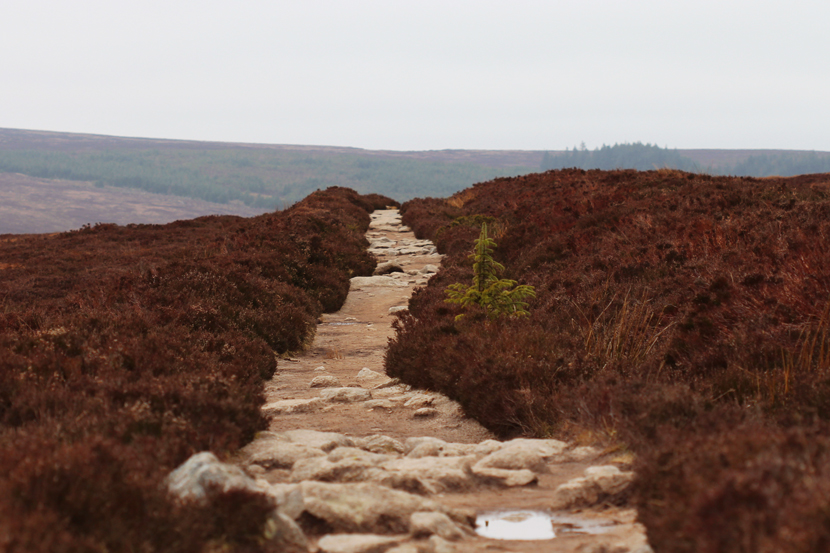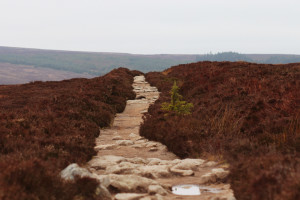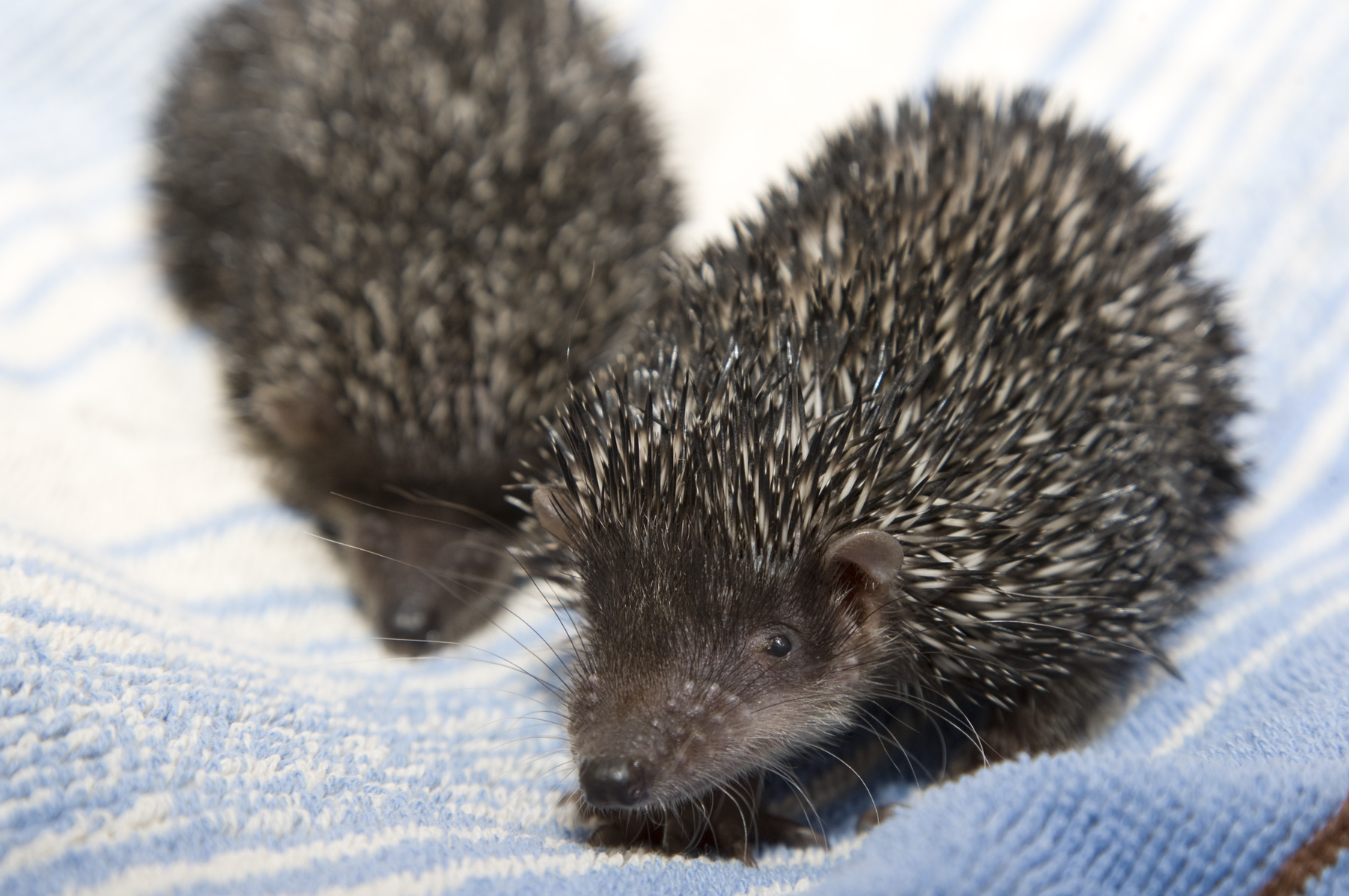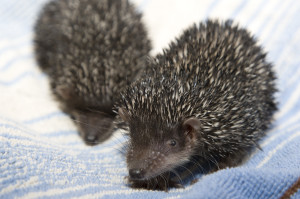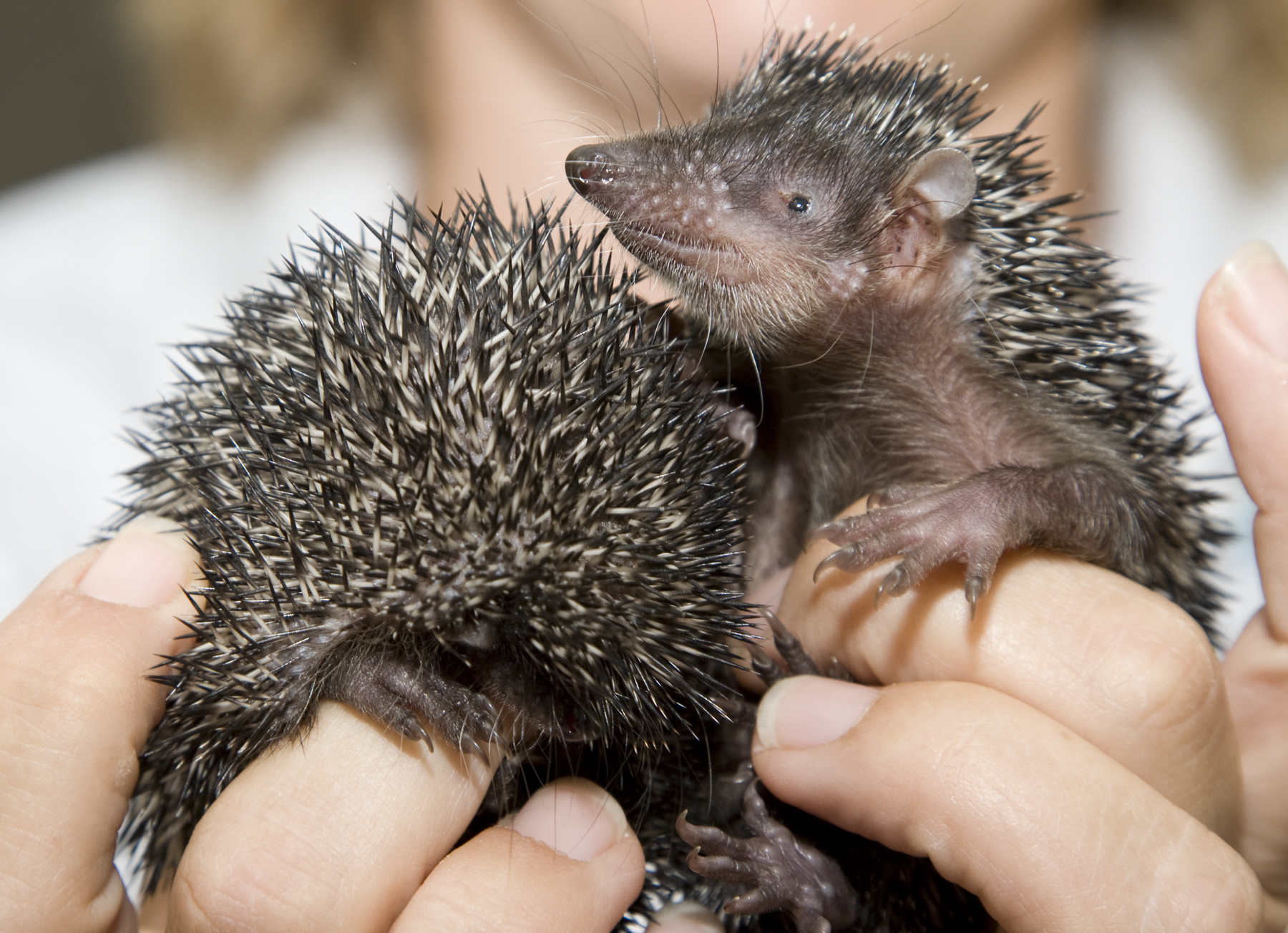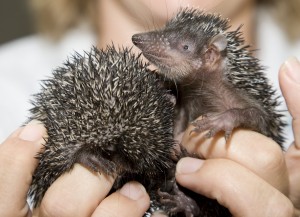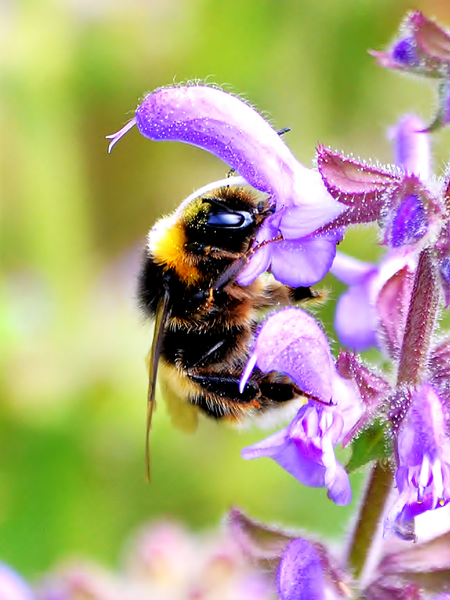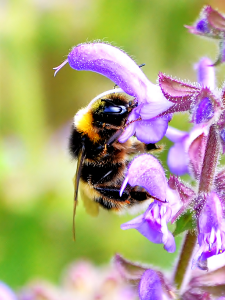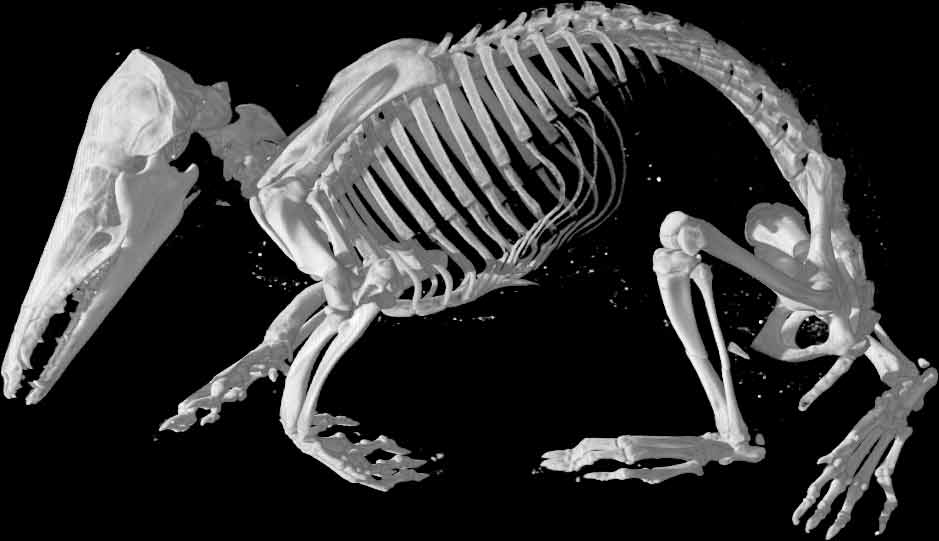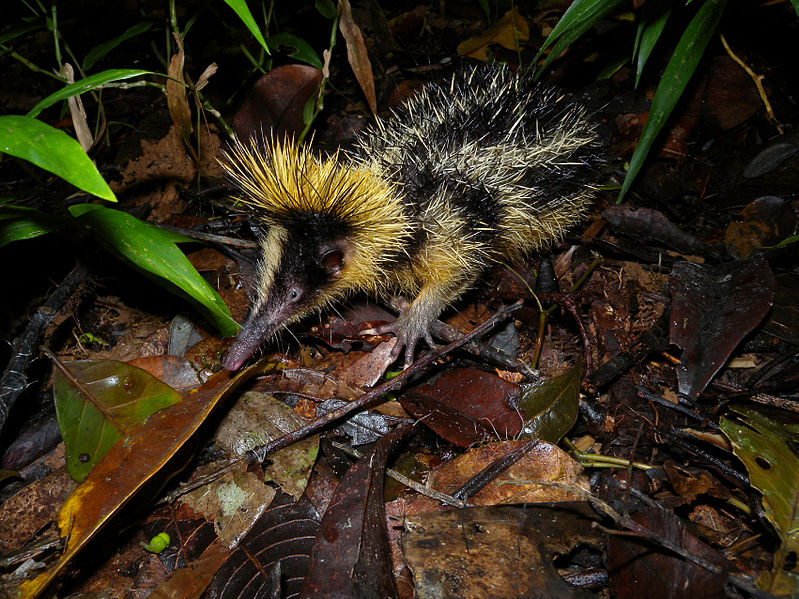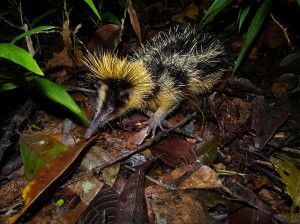Looks can be deceiving
We are all taught not to judge a book by its cover, it’s what inside that counts. Our new paper published in PeerJ shows that the same is true for tenrecs.
These cute Madagascar natives are often used as an example of a mammal family with high morphological diversity. It’s easy to see why: there are tenrecs which resemble shrews, moles, hedgehogs and even otters. These differences are even more remarkable when you consider that tenrecs are more closely related to elephants and aardvarks than they are to any of the small, “insectivore” mammals. One of only four native mammal clades in Madagascar, it appears that tenrecs have undergone an adaptive radiation to fill otherwise vacant, small mammal niches, evolving convergent similarities to other groups in the process.
Tenrecs are clearly very diverse in their appearance. However, prior to our study, no one had tested whether this apparently high diversity was more than skin deep. We tested whether tenrecs were more morphologically diverse than their closest relatives, the golden moles.
We measured the morphology of tenrec skulls and compared their diversity to the shape of golden mole skulls. This meant spending hours poking around the collections of natural history museums and many more hours placing landmarks on skull pictures for 2D geometric morphometrics analyses (Spotify was my friend!)
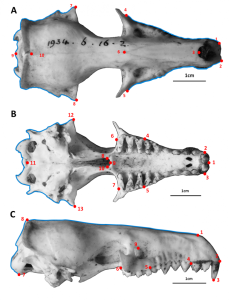
Tenrecs occupy a wider range of ecological niches (fossorial, arboreal, terrestrial and aquatic) than golden moles so we expected that tenrecs would be more morphologically diverse than their cousins. However, we found that tenrec skulls only have more diverse shapes than golden moles when we compared them in lateral (sideways) view but not dorsal or ventral views. These results show the importance of measuring morphology in many different views to gain a more complete understanding of overall morphological diversity.
The tenrec family includes species which convergently resemble many other, un-related small mammals. However, most tenrecs (19 out of the 31 tenrec species in our analysis) belong to the shrew-like Microgale tenrec genus. So, although many people tend to focus on the strange and unusual species (such as the otter shrew, hedgehog tenrec or the bizarre lowland streaked tenrec), most tenrecs are small, shrewy-type creatures that look very similar.
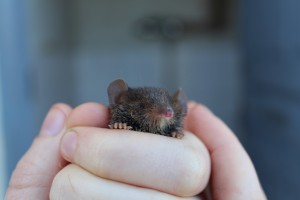
We tested whether the similarities among the Microgale tenrecs might be masking higher morphological diversity in the rest of the family. We repeated our analyses to compare the diversity of golden mole skulls to a sub-set of the tenrec family (including just 5 of the 19 Microgale species). In this case, tenrec skulls were more morphologically diverse than golden mole skulls in all comparisons (skulls in dorsal, ventral and lateral view).
Overall, our results indicate that, while there are clear physical differences among tenrec family members, the majority of tenrecs are quite morphologically similar to each other so morphological diversity in the family as a whole is not as big as it first appears. Of course comparing skull diversity is just one aspect of overall morphology – analysing the shape of other traits such as limbs could yield different results – but our study represents the first step towards a greater understanding of the ecological and evolutionary diversity of tenrecs.
It’s also testimony to the fact that you should never judge a tenrec by its cover.
Author: Sive Finlay, @SiveFinlay
Echolocating Tenrecs
I’m going to Madagascar tomorrow.
I have all the essentials; insect repellent, tent, flat pack wooden box, bat detector, three metres of blackout curtain material… Not the most usual of packing lists admittedly but all necessary items for the trip ahead.
I’m going to study tenrecs; cute mammals which are the subject of my PhD. I’m interested in convergent evolution between tenrecs and other small mammals. So far I’ve been focusing on morphological convergence – work which has involved trips to beautiful museums and taming the dark arts of morphometrics. The primary aim of my research is to assess the evidence for morphological and ecological convergences among tenrecs and the mammals they resemble. Technically I could complete these aspects of the project without ever seeing or dealing with the live animals. But where’s the fun in that?! I’m also interested in behavioural convergences among tenrecs and other mammals, particularly reports of the abilities of some tenrecs to echolocate.
Some shrews produce echolocation calls by clicking their tongues. More recent work indicates that shrews seem to use these clicking calls primarily for navigation within their habitat rather than communication. Intriguingly, there is evidence that at least three species of tenrec; the lesser hedgehog tenrec, lowland streaked tenrec and Dobson’s shrew tenrec, can also echolocate. The animals seem to use their tongue clicks for navigation. The stridulation sounds produced by specialised spines in lowland streaked tenrecs and juvenile tail-less tenrecs have also been linked to having an echolocatory function but immobilising the spines doesn’t seem to affect the animals’ abilities to navigate by sound.
These early experiments are tantalising evidence of intriguing behavioural convergences among shrews and tenrecs. However, limitations of 1960’s acoustic technology and the ever so slight changes in standards of experimental practice (blinding animals with cement doesn’t go down so well with modern ethics boards!) mean that the study of echolocation in tenrecs is ripe for further exploration.
Hence my unusual packing list. My plan is to place wild-caught tenrecs within a box that can be converted into a maze of various layout and complexity (I’m extremely grateful to our super technician, Peter Stafford for making an adjustable maze which can be flat-packed for travel to Madagascar!).

Using a bat detector, I’m going to record the sounds produced by the animals both when they’re “at rest” just in the empty box and when faced with the task of moving through the maze to reach food at the other end. I’m going to observe and film the animals moving through the maze, both in daylight and under red-light conditions in darkness (hence the blackout curtains) and record the sounds they produce as they move. The idea is to test whether the animals’ call patterns (structure/frequency of calls) changes as they navigate their way past an obstacle in the maze. Bats are known to modulate their call frequencies when they hone in on their prey or to navigate their way past obstacles. I want to test whether there’s similar call modification in tenrecs which would provide evidence that the animals are actually using their echolocation sounds for navigation. It would be fascinating to understand more of how tenrecs use echolocation and to test whether other tenrec species can also echolocate.
It all sounds quite straightforward but I’ve experienced some of the vagaries of fieldwork in the past and I’m anticipating many more problems to come. I’ve received advice and war tales from researchers who have tried to study echolocation in shrews only to be thwarted by problems of distinguishing the animals’ calls from background sounds or the noise of the animal’s claws on a wooden base. Similarly, the tenrecs may not want to cooperate with my idea of moving from one end of the maze to another. I’m hoping that a nice juicy earthworm at the other end will act as the metaphorical carrot but there’s no way to know until we actually try it out. Furthermore, it might be difficult to distinguish sounds that say “I’m scared of being in this box” from sounds that the animals are using for navigation. Similarly, since we have neither the option nor inclination to experimentally blind or deafen the animals we won’t be able to completely exclude the possibility that the animals are using other sensory cues aside from acoustic navigation.
Even still, I’m hoping to get results which demonstrate the range of calls produced by tenrecs and which provide clues into how the animals use their acoustic behaviour to their advantage. Echolocation has involved independently in different animal lineages. Most interestingly, there is even clear evidence for convergence at the level of genetic sequences. Hopefully the data I gather over the next few weeks will add to our understanding of this fascinating story of convergence among tenrecs and other mammals.
And maybe we’ll spot a few lemurs on the way…
Author: Sive Finlay, sfinlay[at]tcd.ie, @SiveFinlay
Image Source: S. Finlay
School of Natural Sciences Postgraduate Symposium 2014: Part 4/4
On the 20th and 21st of February we had our annual School of Natural Sciences Postgraduate Symposium. Over the course of two days many of our PhD students presented their work to the School. We also had two interesting plenary talks from Dr Sophie Arnaud-Haond (Ifremer) and Dr Lesley Morrell (University of Hull). Unfortunately our third speaker, Dr Fiona Jordan (University of Bristol) had to cancel due to illness.
For those of you who are interested in exactly what we work on here at EcoEvo@TCD, here are the abstracts from the PhD student presentations. Check out the TCD website for more details!
Ruby Prickett*: Geographical, ecological and genetic characterisation of perennial biomass grasses
*Unfortunately Ruby was unable to attend but we still have her abstract
Evidence suggests that increasing CO2 concentration from fossil fuels in the atmosphere is contributing to global climate change. There is great interest in producing energy from biological sources such as willow (Salix spp.), and the grass Miscanthus. This project aims to contribute to the development of grasses of the C4 genus Miscanthus and several C3 species (Dactylis glomerata, Festuca arundinacea and Phalaris arundinacea) for use as biomass crops, particularly on marginal land. This project aims to produce maps and species distribution models for each of the four species, to identify potential areas for production and their impact on biodiversity; to collect new accessions of Dactylis and Phalaris in the Northwest Europe and Miscanthus in Asia; and to assess the genetic diversity within each species.
Rebecca Rolfe: Identification of Mechanosensitive Genes during Skeletal Development: Functional evidence associated with the Wnt Signalling Pathway
Mechanical stimulation is important for the correct formation of the skeleton. Mutant embryos that develop with an altered mechanical environment result in defects in ossification and joint formation in the limb. We tested the hypothesis that mechanical stimuli influence the regulation of genes important in skeletal development by analysing the transcriptome of muscle-less and control skeletal tissue. We found 1,132 independent genes are differentially expressed with significant enrichment of genes associated with development and differentiation and cell signalling. In particular, multiple components of the Wnt signalling pathway are affected. An investigation of the functional effects of over/ectopically expressing Wnt pathway components in the developing chick will be tested using in ovo and ex ovo electroporation. It will be used to assess whether manipulation of the Wnt pathway in the developing joint mimics the phenotype that is seen when mechanical stimulation is removed, to identify whether or not disturbing the pathway alone causes the phenotypic disturbance seen when mechanical stimulation is removed.
Anurati Saha: The Influence of Mechanical Forces for the Definition of Articular Cartilage
Articular cartilage covers the terminal ends of bones at synovial joints. It allows pain-free movement with injury or degeneration leading to diseases such as osteoarthritis. Current treatment is whole joint replacement but stem cell regenerative therapies would offer a more sustainable solution. Previous research in the lab has shown that appropriate mechanical stimulation from movement of the embryo is required for normal joint formation; joints fuse when movement is absent. My project aims to increase our knowledge of mechanical regulation of joint development in a number of respects and to explore application of such findings to achieve stable differentiation of cartilage for alternative regenerative therapies.
In the first year of my PhD, I investigated the potential of embryonic limb bud cells to form cartilage in micromass culture. This allowed me to establish a protocol to achieve chondrogenesis and revealed the stage of maximum chondrogenic potential. This part of my work will be developed to compare the response of embryonic limb bud cells and adult progenitor cells from different sources (bone marrow and joint derived) to mechanical stimuli in 3D scaffolds, potentially valuable in the refinement of protocols for regenerative therapies
Claire Shea: Mechanotransduction in Skeletal Development: From Embryonic Development to Regenerative Therapies*
*Highly commended
Why do babies kick? Why do astronauts in zero-gravity lose bone mass? What are the causes of osteoporosis and osteoarthritis? The human skeleton allows us to move, but also requires movement for its own development and maintenance. Mechanical forces impact developing tissues, making embryonic movement (kicking and stretching) necessary for normal skeletal development. Understanding how a healthy skeleton forms is also important for skeletal disease therapies which seek to generate replacement tissues by recapitulating the normal developmental pathway with cell cultures. Wnt is a cell-signalling system known to be vital to many aspects of embryonic patterning, and has been implicated in mechanotransduction by our lab. My work focuses on identification of Wnt component genes responsible for transducing mechanical signals such as tension, hydrostatic pressure, or shear into a genetic response in developing joints and bones. To characterise gene expression patterns in normal vs. mechanically-altered environments, and to assess the role of Wnt, I use genetic mutants (mouse) and gene electroporation (chick). My goal is to apply this in vivo information to in vitro efforts, where stem cells embedded in 3-D scaffolds will be treated with an optimal genetic and physical environment to form functional, stable adult bone or cartilage tissue.
Sive Finlay: Tremendous tenrecs: curious convergence and distinctive disparity*
*Best talk 1/2
Understanding patterns of variation in morphological diversity, such as convergence and disparity, remains a challenge in evolutionary biology. In particular, questions of convergence and the predictability of evolution are central to the long-standing debate about the relative influences of historical contingency and determinism in evolutionary processes. Theoretical models indicate that some degree of convergence is expected by chance in most phylogenies. Therefore, quantitative analysis and explicit tests of superficial patterns are essential if we are to identify and understand significant cases of evolutionary convergence. However, most quantitative methods of identifying convergence were developed using relatively few groups for which detailed morphological and ecological data were already known. I want to test the wider applicability and usefulness of such quantitative methods by applying them to a new study group.
Malagasy tenrecs appear to be both disparate from each other and convergent with other “insectivore” mammal species. I’m assessing the evidence for significant morphological disparity within tenrecs and convergences among tenrecs and other mammals using a combination of geometric morphometric techniques and phylogenetic comparative methods. Subsequently, I will establish whether there are correlations between morphologically similar species occupying convergent ecological niches.
Kevin Healy: The evolution of potent venom in snakes*
*Highly commended
The ability of a predator to capture its prey is a fundamental element of ecological interactions. Such interactions can broadly be described as following general scaling laws underpinned by factors such as predator-prey body size difference’s, or habitat complexity. Unlike many predators, the ability of snakes to subdue and capture prey is mediated not by physical size but by their highly evolved venoms. Based on general predator prey scaling predictions I explore the hypothesis that venom potency is affected by ecological factors relating to the ability to quickly subdue prey. The factors I predict to increase venom potency include large prey size and low prey metabolic rate, as they reduce the speed of the venom affects, and habitat complexity, as more complex habitats would allow prey more opportunity to escape. Understanding the general drivers of venom evolution can lead to insights into the evolution of snakes and other venomous species and point to perhaps other untapped venom derived bio-resources.
Erin Jo Tiedeken: The impacts of Rhododendron nectar toxins on Ireland’s bees: deadly meal or valuable forage?*
*Best talk 2/2
Bees provide the valuable ecosystem service of pollination while visiting flowers and collecting nectar. We are currently experiencing a “pollinator crisis,” as pollinating species decline in response to anthropogenic pressures. Moreover, bees may exhibit species-specific responses to drivers of decline.
Rhododendron ponticum is an invasive flowering shrub that causes ecological and economic damage in Ireland. R. ponticum produces floral nectar in order to attract pollinators, but paradoxically this nectar contains neurotoxins called grayanotoxins. Our study investigated the impact of grayanotoxins on three bee species; Apis mellifera, Bombus terrestris, and a solitary Andrena species. For each species we tested whether consumption of nectar grayanotoxins had an impact on (1) survival, (2) consumption rate, and (3) behavior. Our results demonstrate that bees have critically different responses to grayanotoxins. Grayanotoxins are acutely toxic to honeybees, however, bumblebees exhibited no lethal or sublethal effects. Solitary bee survival was not affected, however bees exhibited temporary neurological symptoms after eating grayanotoxins. Rhododendron reduces available forage for honeybees and some solitary bees but could provide an important food resource for certain bumblebees. Our results demonstrate that studies of pollinator decline should include multiple species and should not extrapolate to species other than those included in the study.
Image Source: Wikicommons
Morphological convergence and disparity in Malagasy tenrecs
“I wish to register a complaint…” the first six months of my PhD have passed by far too quickly. As the date of departure for my first major data collection trip looms, I’m navigating the exciting but unnerving transition from the planning to action stages of my project. Fortunately the members of NERD club were on hand to very kindly listen to my ramblings and provide excellent ideas to add to and modify my research.
Here’s the plan so far…
Evolutionary studies have long-been concerned with understanding patterns of variation in morphological diversity. Two aspects of morphological variation which attract particular interest are convergence – the independent evolution of similar morphologies in phylogenetically distant species – and disparity –the range or significance of morphology in a given sample of organisms.
Morphological variation among tenrecs is particularly interesting – they appear to be both disparate from each other and convergent with other species such as hedgehogs, shrews, moles and otters. However, previous studies have neither quantified the degree of convergence or disparity among tenrecs nor attempted to identify reasons for the occurrence of these patterns. My aim is to fill these significant gaps in our understanding of the evolution of such a fascinating mammalian group.
I work with morphometric data compiled from museum collections of tenrecs and the mammals which they convergently resemble (my data collection involves traveling to museums in London, Washington DC, New York and Boston – oh the trials of PhD life!) I use calipers to take linear measurements and also photograph the species’ skulls and limbs. I use geometric morphometric techniques (this article is a great introduction to the murky world of morphometrics) to statistically analyse the degree of morphological (dis)similarity among tenrecs and other species.
I will plot the morphometric data from my species in a “morphospace”, something similar to Brusatte et al.’s 2008 paper on dinosaur morphology. This graphical interpretation will be useful for measuring both convergence among tenrecs and other species and disparity within tenrecs.
In morphospace plots, morphologically similar species sit closer together than dissimilar species. However, from a convergent evolution perspective these patterns are only interesting if morphologically close species are also phylogenetically distant. I will combine and modify existing approaches (e.g. Stayton 2008 and Muschick et al., 2012) to quantify the amount of convergence among tenrecs and other species and also determine whether tenrecs have evolved a higher degree of convergence than expected by random chance. Similarly, if tenrecs are significantly disparate from each other I expect that the range and variance of their morphological variation will be both greater than random evolution models and also significantly different from their nearest sister taxa, the Golden Moles (e.g. Harmon et al., 2003).
Many texts claim that convergent phenotypes evolve in animals that fill similar ecological niches. However, morphological and ecological convergences don’t necessarily go hand in hand so, while this idea is certainly very plausible in tenrecs, it is important to test the assumption. Fortunately relevant data on physical habitat characteristics, species range maps, life history traits and overlaps with potential competitors and predators are readily available from a range of sources (e.g. PanTheria, LANDSAT and the IUCN) so I can model the ecological similarities among tenrecs and other species. It will be very interesting to determine whether morphological convergence and ecological similarities truly correlate.
So that’s my plan for at least the next six months or so. Interspersed with working in major museum collections while taking a break to tap dance in a parade down Constitution Avenue in Washington DC, I think there are interesting times ahead.
Author
Sive Finlay: sfinlay[at]tcd.ie
Photo credits
http://www.digimorph.org/specimens/Hemicentetes_semispinosus/body/
Tenrec tales
Tenrecs are one of the most interesting and fascinating mammal groups yet many people have never heard of them. They are one of only four mammalian groups to have colonised Madagascar, a land filled with evolutionary curiosities.
Tenrecs are a striking example of convergent evolution. From a single colonising ancestor, tenrecs have evolved into incredibly diverse species which resemble moles, shrews, hedgehogs and even otters! Contrary to appearances, tenrecs’ closest relatives are actually the golden moles and elephant shrews (Chrysochloridae). However, physical convergences are so strong that early taxonomists didn’t recognise tenrecs as being closely related to each other, an easy mistake to make when you look at this picture from Richard Dawkin’s 1996 book “Climbing Mount Improbable”.
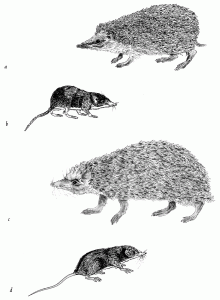
In addition to being great species for studying convergent evolution, the tenrec family includes a whole host of quirky traits. For example, the common tenrec (Tenrec ecaudatus), an animal which is only around 30 cm and 2kg, holds the record for the largest litter size of any mammal at an astounding 32 babies!
My personal favourite tenrec oddity is the unusual means of communication found in the lowland streaked tenrecs (Hemicentetes semispinosus). These cute critters are covered in spiny quills, a special set of which are used as a stridulating organ. Reminiscent of grasshoppers or crickets and uniquely among mammals, these tenrecs rub the quills together to produce sound which then allows them to keep in contact with their family group. This clip from the David Attenborough BBC series on Madagascar shows the stridulating tenrecs in action.
In short, tenrecs are an awesome family filled with evolutionary oddities yet they remain relatively understudied and poorly understood.
In my PhD work, I’m particularly interested in measuring the extent of convergent evolution in tenrecs and figuring out the reasons why they have evolved to be so similar to unrelated species. I’m also intrigued by early behavioural experiments which showed that 3 species of tenrec use echolocation. I want to test whether other tenrec species also echolocate and hopefully link this behavioural convergence to genetic similarities in “echolocating genes” which are conserved in whales and bats.
In the meantime, a charming children’s book gives the perfect excuse for some light, PhD-related extra reading!
Author
Sive Finlay: sfinlay[at]tcd.ie
Photo credits
wikimedia commons
Richard Dawkins

